To achieve reliable transmission of the entire variety of channels, the use of an antenna amplifier may be required.
CONTENT
- 1 Why do you need a TV antenna signal booster
- 2 The device and principle of operation of the TV antenna signal amplifier
- 3 Types of amplifiers for TV antennas for summer cottages and houses
- 4 How to choose an amplifier for a TV antenna
- 5 Rating of the best antennas with an amplifier for home and summer cottages
- 6 Advantages and disadvantages of digital and analog TV signal amplifiers
- 7 How to strengthen the signal of the TV antenna in the country
- 8 How to connect an antenna with an amplifier to a TV
Why do you need a TV antenna signal booster
Television in the modern world is the most widespread means of receiving and distributing information. It is this fact that leads to the fact that increasing the height of the transmitting towers is not just an achievement of engineering thought, but also a way to expand the range of stable broadcasting. It can be achieved only in conditions of direct visibility of the transmitter: when moving away, a decrease in the signal is observed, and both analog and digital broadcasting deteriorate.
Reception stability is ensured only in the immediate vicinity of the repeater
In the first case, without the use of an antenna amplifier of the television signal, a deterioration in quality and the appearance of increased noise are observed. With digital or cable connections, the data transfer rate decreases.
It is possible to improve the quality of received TV broadcasts by using a special device - an antenna amplifier for a TV signal. It should be noted that the use of such an accessory will be necessary only for residents of rural areas who do not have a centralized antenna located on the roof of the house.
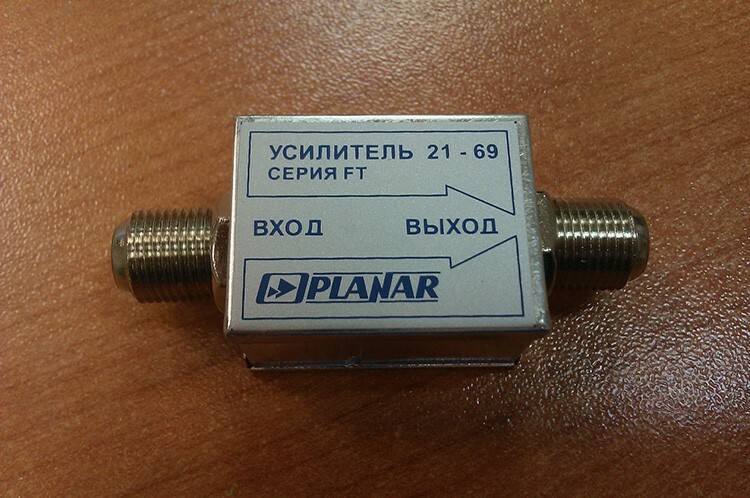
The device and principle of operation of the TV antenna signal amplifier
TV signal amplifiers for a summer residence or apartment have a fairly simple device. These are two boards that are connected to each other through a special circuit used to reduce the amount of noise that can be generated during operation.
To adjust the frequency range, the oscillating circuit is supplied with a capacitor, and the input circuit plays the role of a high-frequency filter. It has a range of operating frequencies. In the first range, the generated frequency characteristics are close to 48.5 MHz, in the second they are equal to 160 MHz. The presence of resistors in the circuit diagram provides the ability to set the desired modes.
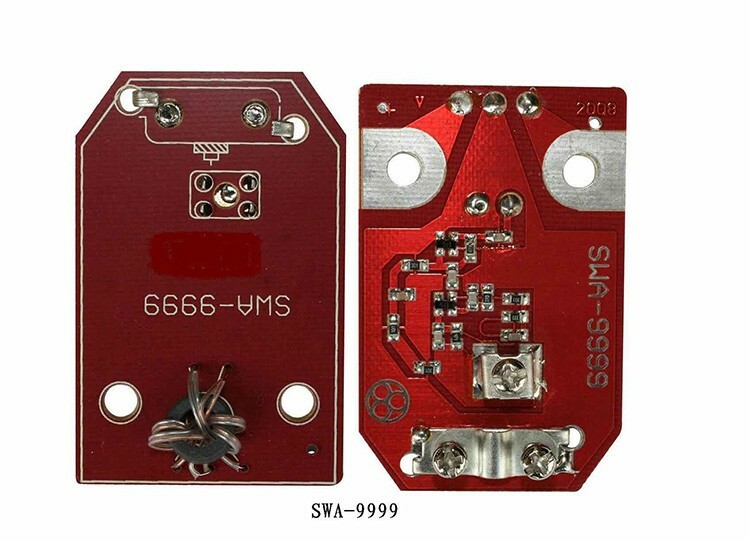
By changing the resistance, you can achieve a voltage of 5 V and a current of 5 A. This provides a maximum signal gain per delta of 4.7 dB at 400 MHz.
Many of the presented TV antenna amplifiers, which can be bought in electronics stores, require a 12V source for power. This makes it possible to connect them to a car battery. To achieve correct operation, you can use a stabilizer in the form of a diode bridge and an electrolyte.
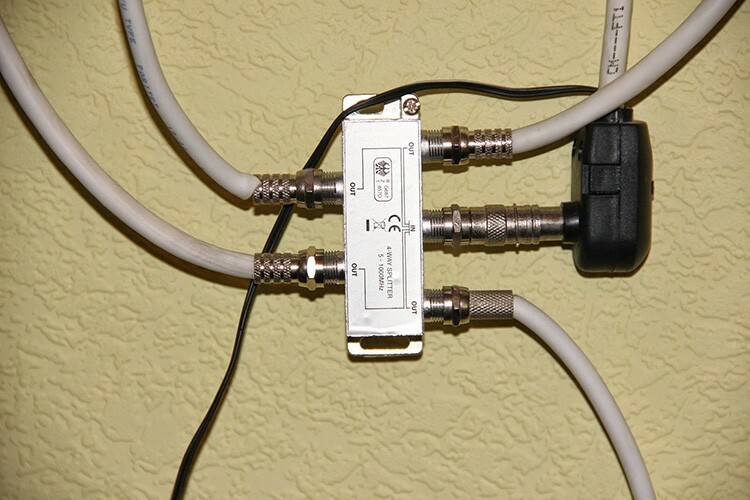
It is allowed to connect an amplifier for a television antenna for giving directly to the source through a coaxial cable, but in this case, the use of a choke is required. Directly the television receiver is connected through a capacitor.
The satellite signal amplifier operates according to the following principle:
- the signal coming from the antenna passes through a matching transformer;
- then it goes to the first transistor, which is connected to a common emitter;
- in the latter, the signal is amplified with parallel stabilization of the operating point;
- then the linear signal is fed to the second stage of transistors, where frequency correction is carried out;
- at the output, the amplified signal is sent to the TV.
TOINFORMATION!
To avoid losses during amplification, one of the resistors is connected to a small-capacity capacitor of the same current, which helps to correct the frequency response of the device.

The mast mount allows you to get open access for the signal from the repeater, since it makes it possible to minimize the effect of interference
Types of amplifiers for TV antennas for summer cottages and houses
There is a common division for all digital TV signal amplifiers that you can buy at your general electronics store. They are classified into types based on frequency range and installation location.

By frequency range
According to this criterion, all presented models can be divided into three types. Depending on the category chosen, different goals are pursued, since each type is used to achieve a certain result. Devices can be:
- broadband. Devices that are most often used as part of indoor home antennas for a TV with an amplifier. Their task is to improve the quality of broadcasting on a large number of receivers at once;
TOINFORMATION!
This type of device demonstrates stable operation in both decimeter and meter ranges.
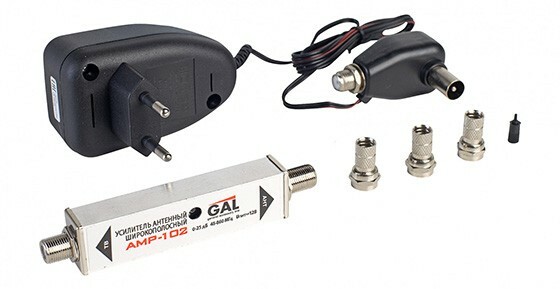
- multi-range. Appliances that are appropriate for receiving devices located on long masts. The most common use of this type is observed in private homes;
- band. Amplifiers that are needed to ensure high-quality reception from a source located at a considerable distance from the receiver. In addition to the signal correction function, these devices have the ability to reduce noise that occurs with increasing cable length. Most often used to improve the broadcasting of digital television in the DVB-T format
At the place of installation
According to this parameter, all the models presented are divided into two types - depending on the features of the installation and installation of the device. So, all antenna amplifiers for a TV of 20 channels or more can be:
- internal, which is a small board that can be installed directly next to the receiver. In this case, there may be a degradation of the signal supplied to the amplifier itself due to cable losses;
- outboard or mastlocated on a long pole at the location of the antenna. Thanks to the long offset, they provide a high-quality signal enhancement. But the main disadvantage can be considered fragility, since a strong wind or a lightning strike will damage the device over time or completely disable it.
Connecting an amplifier requires a 5 or 12 volt power supply.
There is also a division into active and passive amplifiers. In the first case, the amplifier board is mounted directly on the antenna body. This allows you to receive more channels. But there are disadvantages: frequent failure of the board under the influence of external factors and gradual oxidation of structural elements.
The second type involves the use of an external amplifier, which is purchased separately. This is a more profitable option, but it requires additional configuration and installation of the device.
How to choose an amplifier for a TV antenna
When deciding to purchase an aerial amplifier for digital television or analogue broadcasting, you should choose not only by range or location, but also take into account a number of technical characteristics:
- noise figure. The principle applies here - the lower, the higher the picture quality. It is recommended to purchase devices with a declared level below 3 dB;
- current consumption. Optimal devices are considered to be amplifiers designed for consumption from 30 to 60 A;
- gain. This indicator demonstrates the relationship between the distance from the signal source to its consumer. It is recommended to choose the optimal ratio. This means that there is no point in using the amplifier with a line of sight to the repeater. Otherwise, the device should be selected taking into account the coefficient, which is expressed in decibels;
- output value of the signal. The most acceptable indicator is considered to be 100 dB / µV;
- the frequency range, which must coincide with the similar characteristics of the television receiver, otherwise the purchase of an amplifier will be useless;
- antenna type and amplifier model.
IMPORTANT!
It will not be possible to install a broadband amplifier on a range signal receiver.


Rating of the best antennas with an amplifier for home and summer cottages
There are a large number of antennas on the market that have built-in signal amplifiers. Among the available samples are both devices for receiving analogue broadcasting and for "digital".
"Extra" ASP-8

Russian model, which is an in-phase passive antenna equipped with 4 pairs of V-shaped vibrators. One of the main distinguishing features is the ability to upgrade to achieve maximum signal gain. The operating frequencies of the device allow you to receive up to 64 channels in the frequency range from 40 to 800 MHz.
Among the shortcomings, users note not the best build quality. But the manufacturer guarantees that when installed on a mast antenna will be able to withstand wind gusts up to 30 m / s. The cost of the model is 750 rubles.
Antenna array ASP 8
"Meridian-12AF" from Locus
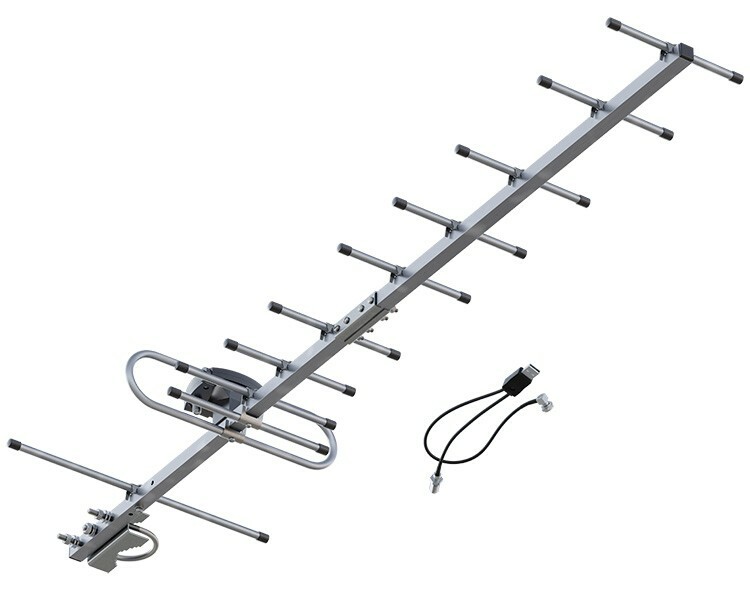
The device, despite its low cost (1300 rubles), has won many positive reviews. This is antenna for receiving on-air broadcasting of an external installation. On the positive side, buyers note the thoughtfulness of the design, which has sufficient rigidity, high gain, allowing you to receive a reliable signal at a distance of up to 70 km from source. The compactness of the model allows it to be installed on masts. The presence of anti-corrosion treatment guarantees a working life for 10 years.
Meridian-12AF
"Hummingbird" from REMO

Another antenna that has an acceptable cost with adequate signal amplification quality. Its cost is 1400 rubles. Since this instance is an active model, it requires an electrical connection. The power adapter has a regulator that allows you to set the gain to a maximum of 35 dB. The metal design of all elements of the device makes it immune to temperature extremes. It can receive both analog and digital channels. The length of the power cable is not very long, so an extension cable is required.
Hummingbird from REMO
Best Antenna Amplifiers
You can buy a ready-made antenna that is equipped with a signal amplification system, or you can purchase this item separately to try to install it yourself.
Locus LA-31

The amplifier is a single-threaded type, which is designed to stabilize the signal and improve its quality. The maximum gain of the device is 22 dB, while the variation is chaotic. Requires protection from the effects of atmospheric precipitation. The cost of the device is 335 rubles.
Amplifier DVB-T2

The product is made in China, despite the dubious origin, it has good performance characteristics. The gain is 23 dB maximum, and the noise level varies from 2 to 3 dB. One of the advantages can be considered a sealed steel case, which protects from atmospheric precipitation. The only weak point is the support for frequencies in the range from 470 to 900 MHz. The cost of the model is 360 rubles.
Alcad AI-200
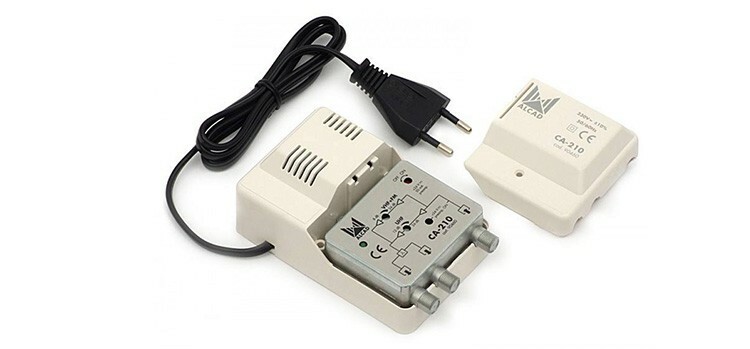
The device of the Italian company, which is the most popular in the territory of the Russian Federation. This device provides high-quality signal amplification, allowing fine adjustment of the centimeter and decimeter range. The noise figure of this accessory does not exceed 4.5 dB. One of the distinguishing features is the function of dividing the signal into two streams, which makes it possible to broadcast to two receivers at once. The popularity of the device is due to its high quality and performance parameters. The cost of the amplifier is 1400 rubles.
Indoor antennas with amplifier for TV
Residents of the first floors of multi-storey buildings may need to purchase a room antenna equipped with a signal amplifier, since the surrounding objects create certain interference. Among these devices there are also leaders.
"Inter 2.0" from REMO

The device of Russian production, which is a multifunctional device with a democratic price. The antenna has the ability to process 20 digital, 10 analog and 3 radio signals at once. Convenient controls help you to achieve the required signal level to achieve maximum quality.
Among the advantages, users note an acceptable cost, which is 890 rubles, an attractive design and ease of installation. Special mention should be made of the power cables and antennas, which have the same length, which allows installation in any place. The disadvantages are the periodic loss of reception stability and the low quality of the plastic from which the case is made.
amplifier remo
Harper ADVB-2120

A model with a wide range of characteristics. The antenna has a wide frequency range: from 87 to 862 MHz, can be used to amplify digital and analogue broadcasting. The design of the device is original, which allows it to successfully fit into any interior. The signal amplifier in this model is powered directly from the receiver or television receiver. This function imposes certain restrictions, but is a positive quality in terms of compactness. The presence of a closed ring allows you to hang the antenna on any convenient object. The cost of the model is 570 rubles.
BAS-5310-USB Horizon from REMO

One of the best indoor antennas, which is also produced in the Russian Federation. Among the advantages, not only the original look should be highlighted, but also a convenient mount that allows you to place the amplifier directly on the TV. Correct setting will allow receiving up to 69 channels. It is also possible to connect to the receiver via the USB port. The antenna is powered by 5 volts, the power supply is included. The only drawback is the short cable. The cost of the model is 850 rubles.
Advantages and disadvantages of digital and analog TV signal amplifiers
The main advantage of using an antenna amplifier is to improve the quality of television broadcasting. It is for this purpose that this category of technology is used. But these devices have their drawbacks:
- the use of a broadband amplifier can cause an overload of the permissible signal levels, which will lead to its distortion;
- the presence of distortions in the video stream with their subsequent superposition will cause the opposite result to be obtained instead of improving the effect;
- difficulties in supplying power to 12-volt devices.
IMPORTANT!
Used power supplies can generate low-frequency ripple, resulting in poor performance antennas, or produce high-frequency oscillations, which also do not improve the characteristics of the antenna receiver.
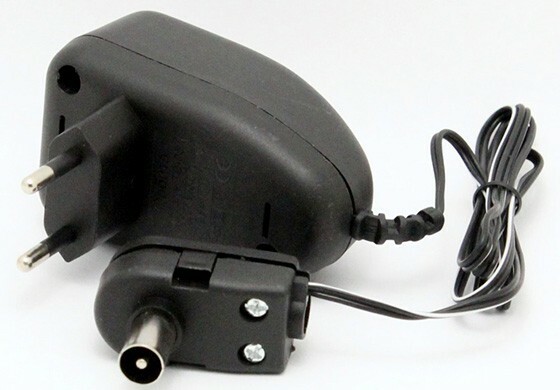
The purchase of a ready-made antenna with a built-in amplifier allows you to get rid of the self-installation procedure
How to strengthen the signal of the TV antenna in the country
There are several ways that can lead to achieving the desired result for improving broadcast in a country house. You can try them before purchasing an amplifier.
- Changing the location of the antenna. You should try to direct it towards the repeater.
- Replacing the existing device with a more powerful one.
- Reducing the number of items that can shield.
- Checking the integrity of the cable.
- An increase in the number of antennas.
But the most effective can be the acquisition of an amplifier, the purpose of which is to improve the quality of the received signal.
How to connect an antenna with an amplifier to a TV
To connect a separate amplifier, you will need to carry out a number of manipulations. They are not so difficult, and for a clear understanding of the process, you can always find video instructions on the Internet. The connection diagram is as follows.
- Coaxial cable stripping. Then it is required to loosen the screws on the terminal for clamping the antenna cable.
- Next, you need to thread the wire in such a way that the braid falls under the bracket, and the conductor under the terminal - without a short circuit.
- Tighten the retaining screws.
- Place the cover on the amplifier.
- Place the device on the antenna through a pair of screw connections. In this case, it is required to place the device with the printed conductors outside.
- Tighten all nuts.
- Connect the cable to the plug and amplifier, observing the polarity.
- Disconnect the TV and connect the wire from the antenna to the receiver.
- Connect the TV and amplifier to the network and start watching.
The procedure for connecting the amplifier to the antenna is not the most difficult, but it requires care and accuracy.
The purchase of an amplifier is a necessary measure in the absence of a stable broadcast reception. Once again, you can see how it is necessary to carry out the installation from the presented video. Do not be afraid to do it yourself, since the process is not particularly difficult.



